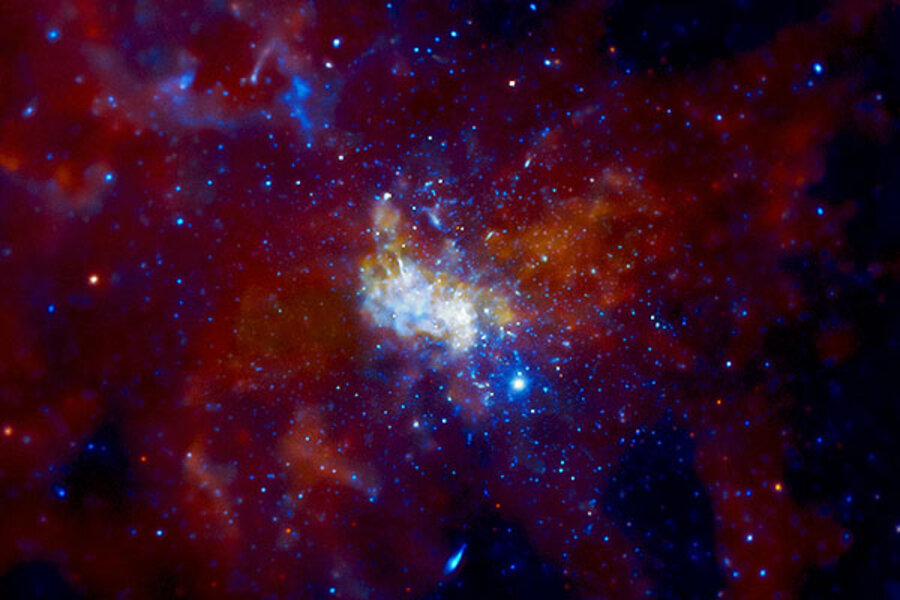At edge of black hole, a star Albert Einstein would have loved
Loading...
Astronomers have found a star whipping around an enormous black hole at the center of the Milky Way once every 11.5 years, potentially providing them with a cosmic laboratory to test Albert Einstein's most famous theory and to learn more about how such huge black holes evolve.
No known star orbits a supermassive black hole faster. Though it is among a group of stars discovered at the galactic center, it is only the second with an orbital period of less than 20 years. The other orbits once every 16 years.
By looking at precision measurements of these two stars when they are nearest the black hole, scientists hope to see if Einstein's general theory of relativity still holds true under the most intense gravitational field the galaxy can deliver.
Moreover, the stellar pair also are expected to help solve puzzles surrounding black holes in galactic centers and how the black holes affect a galaxy's evolution, notes Andrea Ghez, an astronomer at the University of California at Los Angeles and the leader of the team reporting the discovery in Friday's issue of the journal Science.
"It is the tango" of these two stars "that will reveal the true geometry of space and time near a black hole for the first time," she said in a prepared statement.
According to general relativity, gravity results from mass. That mass – a planet, star, or black hole – warps space and time in its immediate vicinity, a bit like the depression a medicine ball can form when it's placed on a trampoline. This is called a gravitational "well."
A black hole is an object with so much mass – it has warped space and time around it so much – that not even light has enough energy to escape its gravitational well. Stellar-mass black holes, which form from the collapse and explosion of stars at least 10 times more massive than the sun, tip the cosmic scales at between three solar masses and tens of solar masses. The supermassive black hole at the heart of the Milky Way, by contrast, boasts 4 million times the sun's mass.
If a sun-like star were to approach within about 93 million miles of the Milky Way's central black hole, it would in essence become a spaghetti-like streamer of gas destined to vanish into the black hole, says Avi Loeb, chairman of the astronomy department at Harvard University.
The stars that zip around the Milky Way's black hole can reach speeds of up to 22 million miles an hour – a pace that would cover a trip from New York to Los Angeles in less than a second.
The short-period stars among them represent a bonanza for several reasons. First, one complete orbit occurs within a span of time that falls well within the length of a career in astronomy.
Beyond the attraction of getting results before getting a gold watch, the discovery could represent the first in a larger population of dim stars at the galactic center.
The star at the center of Friday's report, dubbed S0-102, is substantially dimmer than the star with the 16-year period, dubbed S0-2. In the rest of the galaxy, faint stars outnumber bright stars, so detecting such a dim star in this region "opens the door to detecting many more in that environment, if they exist," he says, allowing for increasingly precise tests of general relativity, Dr. Loeb suggests.
The effects related to general relativity can be seen in the impact supermassive black holes have on the stars' orbits as they make their closest approach, he adds.
Like Earth orbiting the sun, stars do not travel around black holes in circles, but ellipses – meaning they are sometimes closer and sometimes farther away. But instead of tracing the same elliptical orbit repeatedly, as the Earth does around the sun, the elliptical orbits of short-period stars should shift with time, tracing a rosette pattern around the behemoth.
In addition, changes in the intensity of the black hole's enormous gravitational pull as the stars make their closest approach should also affect the apparent speed at which light travels from the star, as seen from Earth. Dr. Ghez and colleagues note that this effect is too weak to see around an object like the sun, or even around more massive objects such as neutron stars. But with S0-102 and S0-2, the effect should appear as light shifting further into the red end or blue end of the spectrum as the stars orbit nearer the black hole. If Einstein is correct, the black hole's warping of space should make the shift in light more pronounced than under than would be the case under the picture of gravity Sir Isaac Newton drew.
Beyond putting Einstein to yet another set of tests, Leob says, these short-period stars also could help answer a question that continues to dog astrophysicists: What's feeding the Milky Way's black hole?
The black hole at the Milky Way's center is dormant – it's not emitting the vast amounts of radiation that supermassive black holes on a feeding frenzy do. Yet infalling matter is emitting enough radiation to let researchers know that the black hole is partaking in the cosmic equivalent of light snacks.
The source of the snacks could merely be interstellar gas close to the black hole. It also could be gas shed in the form of stellar winds from close-in stars. "The more stars we find, the better the constraints we will get about the origin of the gas that reaches the black hole," he says.
Ghez's team discovered both short-period stars using the Keck telescopes, which sit atop Hawaii's Mauna Kea. But the ability to make precise measurements needed to test Einstein's theories will have to await the construction of a new generation of Earth-based telescopes with light-gathering mirrors are three times the size of Keck's the team holds.





